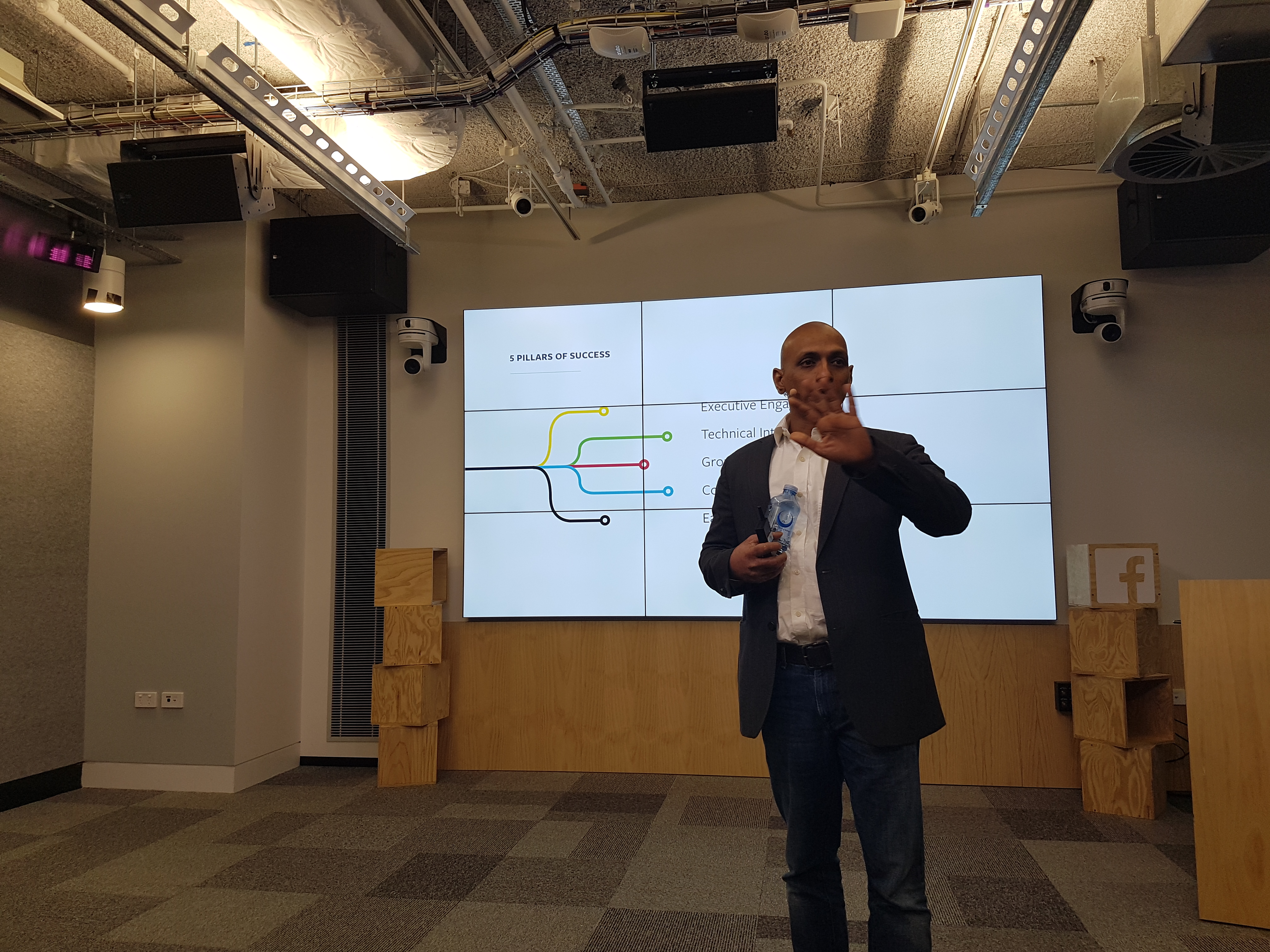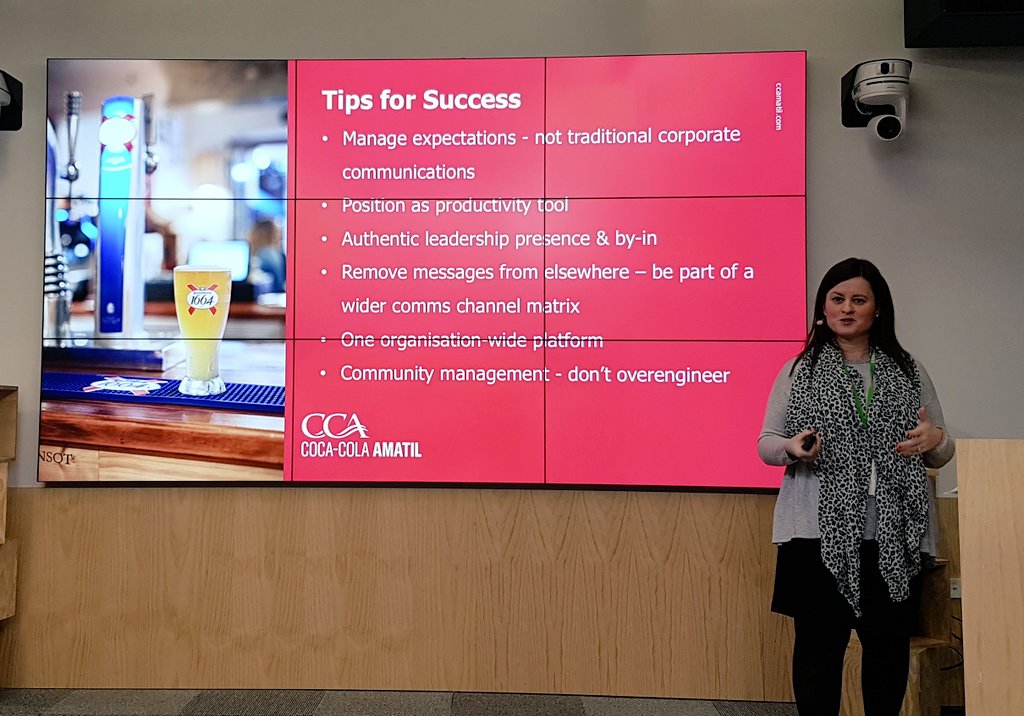Workplace by Facebook - The same but different
2017-31-05
On Tuesday I attended a "Facebook Workplace for Newbies" workshop at Facebook's Sydney office. I'm actually pretty familiar with Workplace already, but it's not that often we get to hear directly from global vendors like Facebook and I thought this would be a good chance to hear first hand how they are positioning it with Australian organisations. As a bonus, we also heard from Coca-Cola Amatil's Phillipa Davies about their experiences with Workplace.

Attending the workshop reinforced my view that while Workplace's underlying proposition is not anything different from past platforms, particularly Yammer, it also offers something different. I'll get to this later, but in part this is because I believe Facebook's roadmap is what will differentiate it and give it longevity.
Why Workplace?
Let's begin by looking at why Facebook believe companies should consider Workplace.
We all know that Facebook's 13 year history is primarily as a public and consumer-oriented social network, with a business model based on advertising. However, there is a precedent for using Facebook for business purposes - both formally and informally.
Facebook say that Workplace is really a reflection of extending their mission to connect everyone, which includes where they work. Workplace started as an internal hack used within Facebook but eventually emerged from an extended beta period, having been successfully proven with hundreds of customers.
They believe that the reason Workplace is having success is because it is better able to meet the needs of a new generation of workers and is reaching those who were previously excluded from even the most recent wave of enterprise collaboration tools. But with Workplace's foundations as one of the leading consumer social networks, they are on the front foot of being able to support the shift away from a bias for text-based communication to a preference for rich-media, particularly video and eventually virtual reality.
Employees also no longer need to resort to shadow IT to overcome the limitations of what is sometimes decades old enterprise technology, as Workplace delivers the consumer user experience they want.
Workplace also has some other features that make it stand out including:
- Native mobile apps for Workplace and Work Chat messaging, which are entirely separate from the consumer Facebook apps
- Support for 100 languages and auto-translation is built in
- The ability to collaborate with other organisations using multi-company groups
- Integrations with enterprise file sharing services, like Box, Google Drive, and Microsoft OneDrive
- Work Chat also supports voice and video calling, and live broadcasting
Facebook also have a simple no-lock in pricing model, that is based on month-by-month active users.
Some of their arguments are very much the same we have heard from other collaboration software vendors over the years, including the goal of reducing reliance on email. More recently we have also started to hear a focus on the need to support teams, so Workplace is not alone positioning itself this way.
Looking back over all these reasons for Workplace, one thing I did notice that was missing was the workplace revolution rhetoric and advocacy that was part of the promotion to users used by solutions like Yammer and Jive. While the Workplace team did share a quote from Mark Zuckerberg on screen that "Workplace is a different way of running a company", there was really no call for working out loud or to create "responsive organizations". It felt a lot more pragmatic or perhaps Facebook feel it is self-evident that this is a better way to work and collaborate?
Implementation approach

Facebook's implementation approach is based on addressing 5 Pillars:
- Executive Engagement
- Technology Integration (primarily this is about single sign-on setup)
- Groups Structure
- Communication Strategy
- Early Champions and Training
This can be completed in as little as 4 weeks, however the initial pilot or beta phase can take longer. The Workplace team recommended that this phase should not take longer than 8 weeks, but they also observed that Australian organisations often needed that time to address governance, business case, and management approvals.
They shared some other tips on the mistakes organisations often make:
- Not getting leadership buy-in
- Failing to resource Workplace beyond the launch - for example, community management
- Ignoring the importance of mobile for adoption
They also recommended that other competing collaboration and communication channels are shut down, including email newsletters and other group collaboration and messaging tools.
To be completely honest, this approach is very consistent with how I have been advocating the adoption of groupware and then enterprise social software over the last decade and a half. What of course has changed is the speed at which cloud-based solutions that require minimal configuration can be implemented.
The one thing I would emphasis based on my experience is to consider early how Workplace fits into your overall digital workplace or intranet vision and what impact this will have, particularly if you have an existing intranet. For example, there is currently no easy way to integrate Workplace and SharePoint.
Beyond that vision process, Workplace itself is simple and straightforward to implement at a technical level - you just need to configure and plan your group structure, with the rest of your effort really being focused on people. More complex integrations can come later.
This approach was very much backed up by Coca-Cola Amatil's experience with Workplace, which I have seen first hand. They implemented Workplace over 27 days and after 6 months are about to hit the 80% adoption milestone. Critical features that led them to introduce Workplace included its ability to live stream video and multi-lingual support. These have proven to be an essential part of their successful implementation of Workplace into a diverse company with people working across Australia, New Zealand, Indonesia, Fiji and Papua New Guinea.

Phillipa's advice was that:
- Manage expectations - this is not traditional corporate communications
- Position Workplace as a productivity tool
- Ensure you have authentic leadership presence and buy-in
- Remove duplicated messages from elsewhere, but be smart about using Workplace as part of your overall communication matrix
- Implement Workplace as one organisation wide platform
- Don't over engineer community management (this is about engagement, not moderation and strict governance)
Could you or should you replace your intranet with Workplace?
Eventually someone asked the question that always gets asked: Can you replace your intranet with Workplace?
Even before Workplace, this was a contentious issue and broadly speaking the answer hasn't changed much - it depends on your expectations of what an intranet is and what it needs to do. In addition, Workplace itself has been specifically criticised for its limited search functionality and currently has limited functionality to publish reference content. But for what it lacks in those traditional intranet features, it makes up for in its ability to reach further across organisations and to users that either couldn't or never used the intranet.
And right now, if you choose to replace your intranet with Workplace, many of the workarounds and hacks I have seen used with tools like Yammer will work well enough to achieve a similar outcome.
But as I said at the beginning - Workplace is the same, but also different. The role of traditional intranets as content platforms is already being hollowed out by other solutions, for example content that might once have lived on the intranet is migrating to HR and IT self-service systems. Text-based intranets are also being challenged by the effectiveness of rich-media to communicate important corporate information to a wider audience. In this context, Workplace is better placed to meet the requirements that traditional intranets are no longer doing effectively or to integrate with other systems that now host that content.
Bots and chatops for business users
Static content on intranets has always been a means to end. Workplace's potential isn't to replace your web content management system, but to be more productive by reducing the friction around non-value adding tasks. And this brings me to the final take away of the event: If Workplace has any say in the matter, the future of intranets and the digital workplace is going to have healthy dose of bots and "chatops" for business users.

A word of caution about bots before we all get carried away. Experience tells us that we will need to move through the hype curve before we get to real productivity. Many organisations are going to waste a lot of money building bots that are either too simplistic or miss the mark on meeting real user needs. But Workplace is setting the scene for a dramatic change to the intranet landscape in coming years. Even if you somehow avoid using Workplace in your organisation, you should watch progress with interest and observe how other vendors, including Microsoft who also have their own bot and bot-related technology offerings (for example, check out QnAmaker), also respond to it.
Love it or hate it, Workplace is injecting fresh opportunities for digital workplaces and intranets.